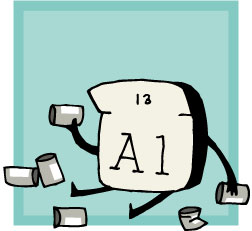Blogging the Periodic Table

Certain elements (gold, silver) haven't gone out of fashion in millennia and probably never will. Others seem unlikely ever to win popularity with the public (hello, praseodymium). Still other elements languished for decades as dirt before zooming to prominence recently (silicon), while some debuted brilliantly but have slowly dwindled in esteem ever since (radium). But no element on the periodic table has had quite as strange a ride as aluminum.
Aluminum is the most common metal in the earth's crust, almost twice as abundant as iron. And one common class of aluminum minerals, collectively called alum, has been in use since at least Greek and Roman times. (Alum, an astringent, is also the powder cartoon characters like Sylvester the cat sometimes swallow that makes their mouths pucker.) But there's no easy way to extract aluminum (unlike iron) from ores, no matter how much you heat them. No one succeeded in isolating aluminum until a German chemist extracted a few flakes in the 1820s. But when he did, aluminum became an instant hit.
Above all, people adored Element 13's color and luster, which reminded them of the sparkle of gold and silver—a brand-new precious metal. In fact, aluminum became more precious than gold and silver in the 19th century, because it was harder to obtain. The French government once displayed Fort Knox-like aluminum bars next to the crown jewels, and the minor emperor Napoleon III reserved a prized set of aluminum cutlery for special guests at banquets. (Less favored guests used gold knives and forks.) The United States, to show off its industrial prowess, even capped the Washington monument with a six-pound pyramid of aluminum in 1884.
But the aluminum market suffered a mighty crash shortly thereafter. Entrepreneurs in the United States and Europe finally figured out how to separate aluminum from minerals cheaply and also how to produce it on an industrial scale. They did so by running a current through a bath of liquid with dissolved aluminum ore in it. The electricity shocked the dissolved aluminum molecules, knocking them out of solution, at which point small gray nuggets collected in the vat. *
From a world production total of perhaps a few ounces per month in the decades before, by 1888, the largest U.S. aluminum company (the one that became Alcoa) could produce almost 50 pounds of aluminum each day. Within 20 years, it had to ship out 88,000 pounds per day to meet demand. As production soared, prices plummeted. In the mid-1800s, the first aluminum ingots on the market went for $550 per pound. Fifty years later, not even adjusting for inflation, it cost 25 cents for the same amount.
And with that drop, the most coveted metal in the world became the utterly blasé metal we all know today—the basis for soda cans, pinging Little League bats, and airplane bodies. (It still sits atop the Washington Monument, too.) I suppose it depends on your taste and temperament whether you think aluminum was better off as the world's most precious or most productive metal.
Correction, July 30, 2010: The article originally statated that aluminum ore was dissolved in a bath of water. It's a bath of liquid cryolite, a mineral. (Return to the corrected sentence.)
Like Slate on Facebook. Follow us on Twitter.